His grandmother’s song was silenced, but art helped Reko Rennie find his voice
Reko Rennie’s grandmother, Julia, once had the opportunity to follow her dream. It didn’t work out. “Her passion was to sing,” the visual artist tells me as we share lunch in a busy Fitzroy restaurant. “She wanted to be an opera soprano, and she had an amazing voice.”
As the groups of diners around us lose themselves in their own conversations, Rennie explains how “a lot of families would adopt Aboriginal children or young adults, basically to be maids or servants. And so that’s what happened with her.” He pauses. “She was adopted to basically be the maid or servant for this family on Mount Tamborine in Queensland.”
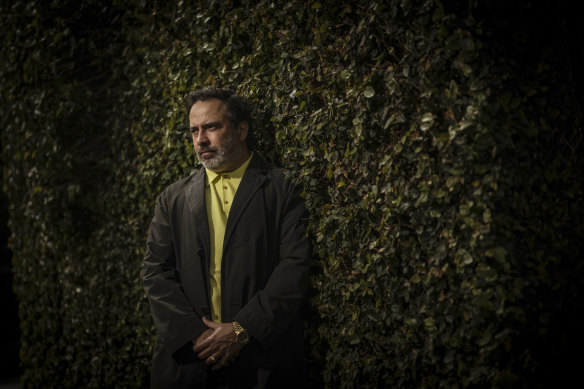
Artist Reko Rennie.Credit: Chris Hopkins
Julia’s talent for singing led to her winning a music Eisteddfod and being offered a chance to go to Los Angeles. “They wouldn’t allow her to go,” says Rennie matter-of-factly. “And so that crushed her dreams of being a musician.”
His grandmother’s story lies at the heart of many of the Kamilaroi artist’s works, which blend activism with exploration of identity and culture.
We’re at Napier Quarter, and it’s small but bustling despite being located on a quiet street – it’s the kind of restaurant you don’t stumble across; you need to be looking for it. “They’re the good ones, right?” Rennie says with a smile.
“One of the standout dishes is the anchovy with sliced egg on toast, that’s pretty nice,” he says. “Shall we get one each?”
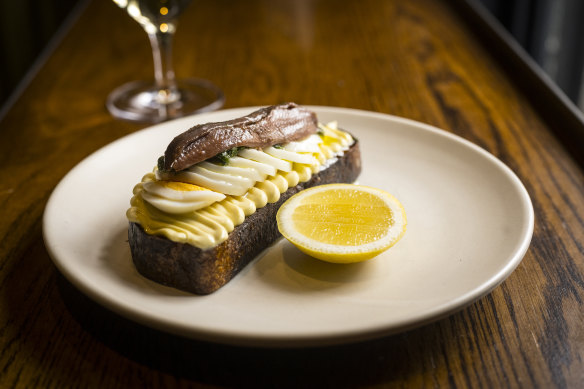
Anchovy toast at Napier Quarter.Credit: Chris Hopkins
Rennie tells me that he’s here “once a week at least – probably a couple of times a week”. It’s not far from his studio, and it’s a favourite for a lot of different creatives.
It’s rare for Rennie’s work not to be the focus of an exhibition somewhere in the world. He has been exhibited at the Venice Biennale and Art Basel in Hong Kong, and his pieces are held in collections across Australia and internationally. He was also formerly a journalist, including for a time at The Age.
Currently his work is the focus of Rekospective, a sprawling exhibition at NGV Australia that looks back over 20 years of his career.
As we wait for our food, Rennie talks me through the different forks in the road that led him to make art, and inform what he uses it to say. Family history. Politics. The need to have a voice.
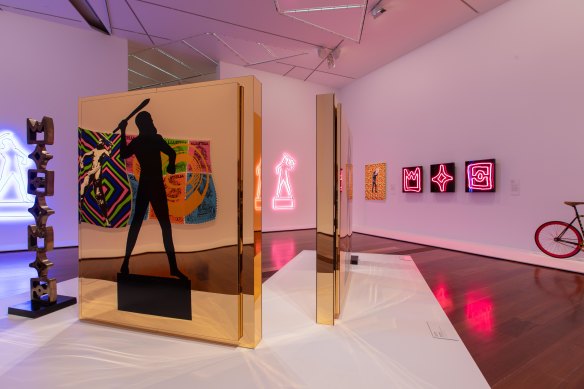
Installation view of Rekospective: The Art of Reko Rennie, on display at The Ian Potter Centre: NGV Australia.Credit: Kate Shanasy
His work is bright, fierce and colourful. When I later visit Rekospective, the first thing I notice is the glow of pink neon, and then the hum of music that drifts through the many rooms – the soundtracks to a series of video works that explore Rennie’s connection to country and his own history.
Two video works hark back to his grandmother’s story. In OA_RR, Rennie drives a painted Rolls-Royce through Kamilaroi country, near where Julia was born. Across a small walkway, into the next room, Initiation OA_RR sees him behind the wheel of a pink Holden Monaro.
“I was this western suburbs, olive-skinned kid that grew up in a very working-class environment, not much money, pretty poor.” Initiation OA_RR is about growing up in Melbourne’s west, “a very tough experience and riddled with crime and drugs and law and justice”. He painted the car pink as a challenge to the toxic masculinity prevalent in the area at the time. “I grew up around that, you know, I learned jiu-jitsu. I learned martial arts to defend myself because I had to.”
The soundtrack is an operatic work by Deborah Cheetham Fraillon, backed by the Melbourne Symphony Orchestra. “She’s truly one of the national treasures of Australia,” says Rennie. When he was creating the piece, he reached out to the composer and singer “and I said ‘Look, you know, I want to give you some language from my grandmother and from my community’. And she was amazing. She wrote this song about me taking wings.”
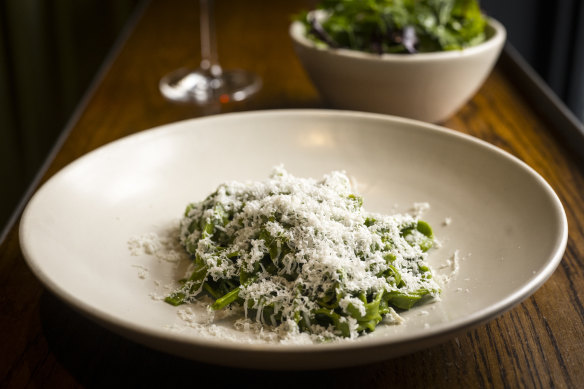
Pasta, nettle, broad bean and ricotta salad at Napier Quarter.Credit: Chris Hopkins
We debate whether to order something else and decide on the nettle pasta and steak to share. Rennie gives his complete focus, whatever the task at hand; he cuts up his toast very methodically and neatly, and he doesn’t jump from topic to topic.
As an artist, he is self-taught. He started with graffiti at age 12 and quickly became part of a larger community. “There was this huge network of like-minded kids, young kids and older teenagers, all part of these different crews and gangs.” Everyone came from different communities and backgrounds, he highlights, “but what everyone shared was this ability to do paint and do damage, and have a form of expression”.
When Rennie started learning more about his family history “it was like this light-bulb moment where I [went] f---, I could take this skill set I’ve got and then start making some work about personal politics on the street,” he explains. So, by the early 2000s, he had shifted to stencilling. “I gave up illegal graffiti in 1995,” he stresses.
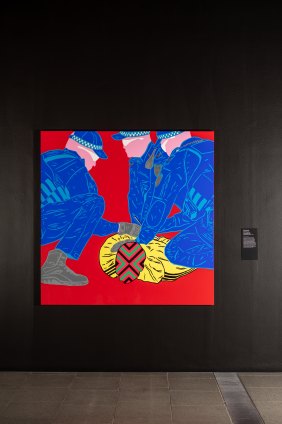
Installation view of Three Little Pigs, 2024.Credit: Kate Shanasy
Rennie kept making art even after his career as a journalist began with a cadetship in Wagga, where he worked in television, before he moved to print and started covering court cases.
“There’s a lot of death and misery and when you’re reporting on that week in, week out … I’m pretty sensitive to that. So it’s just like, how many times can you report on a child dying or someone being murdered ... or going to a court case and hearing about some piece of s--- that’s murdered his wife because of domestic violence, you know?” he recalls. “And at that same time, I was painting at night, painting on my kitchen floor, and I realised that painting was my real passion.”
His ethos of art as a way to be heard carried through. “With art I’d won some competitions, got some shows, won some awards and I thought: I’ve got more of a voice through my art than I do as a journalist, writing about Aboriginal issues and history and identity and politics.”
When in 2009 he was accepted to the prestigious Cite Internationale des Arts residency in Paris he didn’t hesitate. “It was very easy to go ‘you know what, I’d rather paint and talk about stuff that’s really personal’– and because of my identity and my connection and who my grandmother was and what happened to her, you know, I have a responsibility.”
Rennie is constantly working, constantly looking at what form best suits his ideas. With every residency and exhibition he builds up his skills and his outlook, his concepts coming out in new ways.
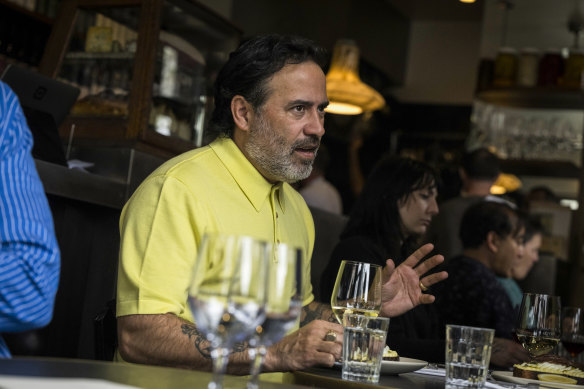
Artist Reko Rennie at Napier Quarter.Credit: Chris Hopkins
He tells me about a new video work he is planning centred on police and on brutality in custody. Another work, Remember us, was created following a residency in Rome where he learned to work with marble. “Taking those traditional, Eurocentric mediums and then juxtaposing it with First Nations, contemporary ideas and politics, it’s a very powerful thing. It’s like you’re reclaiming these mediums and materials of colonisers,” he explains.
Remember us consists of a large stone tablet with the number of Aboriginal deaths in custody carved into it – a number that quickly went out of date. “We’ve got this ongoing international travesty, deaths in custody occurring every year, and hundreds and hundreds of people are dying every year, and we only represent 3 per cent of the population,” he says.
Art as a method of shining light on ongoing issues, for telling stories that need to be heard, is a recurring theme.
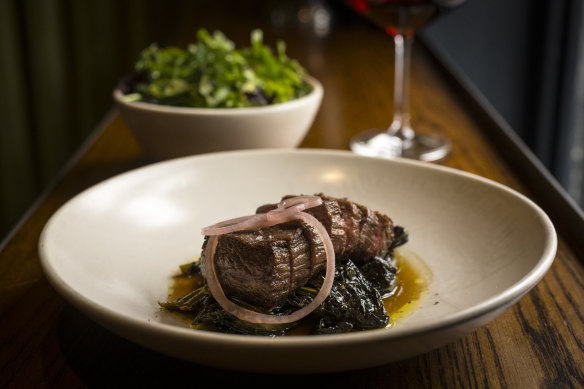
Steak, braised spring greens and lemon myrtle at Napier Quarter.Credit: Chris Hopkins
And while he emphasises the importance of showcasing Australian contemporary art on the world stage, at the same time is wary. “Still within the arts, I’m not black enough to be considered an Aboriginal artist, but I’m not white enough to be considered a Western man,” he says. “I think it’s important to be able to have that ability to break those stereotypes and talk about your work.”
The stereotypes, he explains, also feed into the narrow slice of First Nations art most frequently displayed: “We’re unfortunately lumped into this monoculture when we’re not.”
He points to the myriad language groups and cultures, and how these aren’t reflected in the commonly held view of what makes up First Nations art. “Just look at New York at the moment, where First Nations art is going off. But it’s only a particular version of First Nations art – it’s a very skewed representation,” he says.
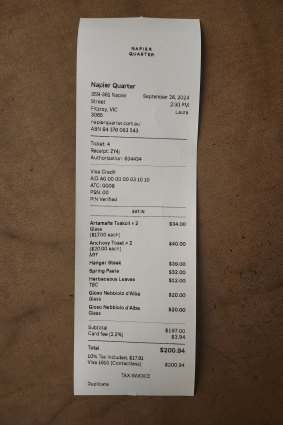
The bill at Napier Quarter.Credit:
“I think there needs to be a greater representation. It’s almost like showcasing someone’s work in Italy and [saying] ‘This person represents all of Europe’ when that’s not the case,” he says. “It’s important to reflect the contemporary diversity of us as a nation. That’s what I’d like to see a lot more. We’ve got artists like Yhonnie Scarce working in glass, myself, artists working in ceramics, metalworks, it’s so diverse – why does it always have to be the dots and bark?”
There’s a lot of exciting work being created that doesn’t fit preconceived notions. The problem, he says, is “gatekeepers that kind of keep pushing this stereotype, romanticised view of [Indigenous] authenticity”.
“It’s really dangerous. It just really limits everyone else from getting into that international sphere.”
He pauses. “It’s what I’d like to see change. I think it will. It will slowly change.”
Rekospective: The Art of Reko Rennie is on at The Ian Potter Centre, NGV Australia, Fed Square until January 27.
The Booklist is a weekly newsletter for book lovers from Jason Steger. Get it delivered every Friday.